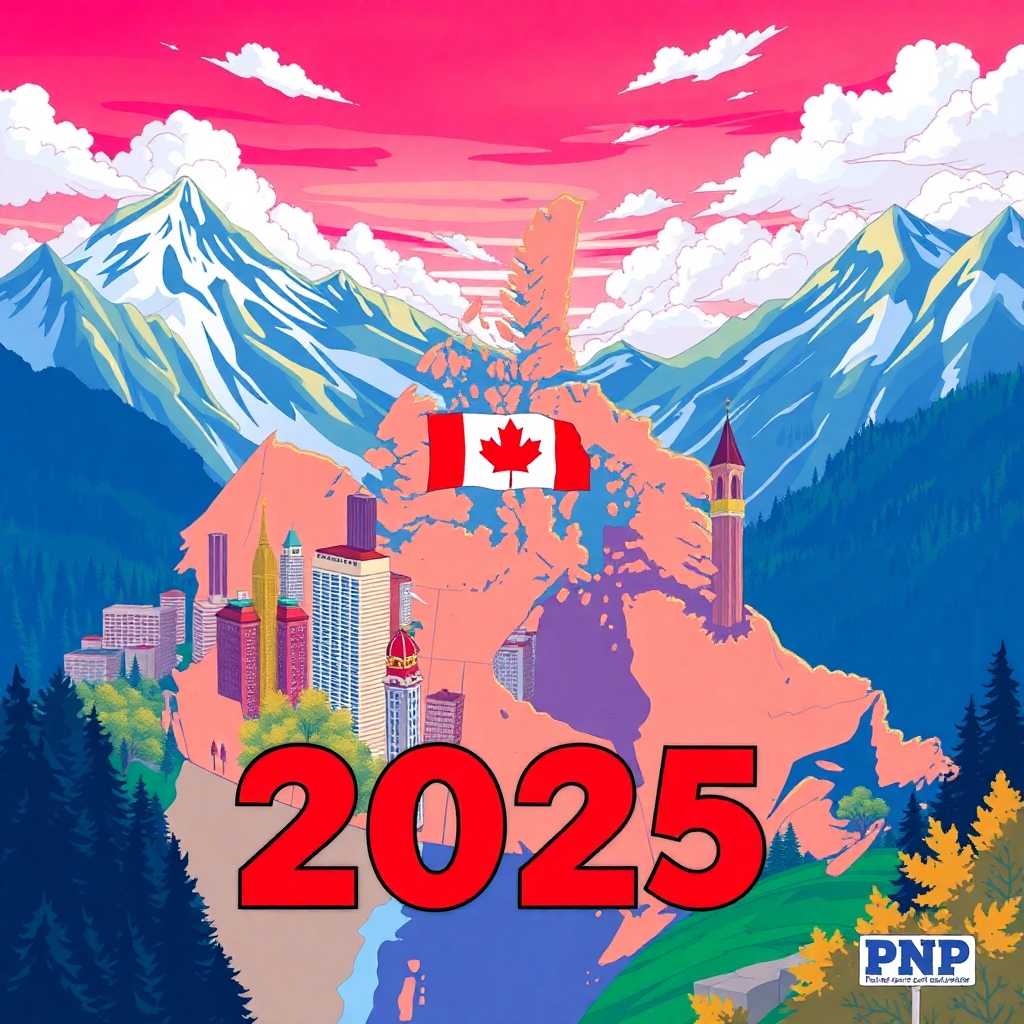
Canada’s 2025 PNP Quota Cuts: What You Need to Know
In a dramatic policy shift, the Canadian federal government has reduced Provincial Nominee Program (PNP) allocations by 50% for 2025, slashing total nominations from 120,000 to 55,000. This unprecedented cut impacts provinces and territories reliant on the PNP to address labor shortages and drive economic growth. Below, we break down the changes, province-specific impacts, and what this means for future immigrants.
2025 Provincial Nominee Program (PNP) Quota Comparison
| Province |
2025 Quota |
2024 Quota |
Reduction |
| Ontario (OINP) |
10,750 |
21,500 |
50% |
| British Columbia (BC) |
7,586 |
~15,100 |
50% |
| Alberta |
4,971 |
9,942 |
50% |
| Manitoba |
4,750 |
9,540 |
50% |
| Saskatchewan |
3,625 |
7,250 |
50% |
| New Brunswick |
2,750 |
5,500 |
50% |
| Northwest Territories |
150 |
300 |
50% |
| Yukon |
215 |
430 |
50% |
Key Impacts of the 50% PNP Reduction
-
Labor Market Gaps:
-
Provinces like British Columbia, Ontario, and Alberta, which rely on PNP to fill critical roles in healthcare, tech, and trades, may struggle to address shortages.
-
Industries such as construction and education face heightened risks of project delays and service gaps.
-
Regional Economic Disparities:
-
Smaller provinces (New Brunswick, Saskatchewan) and territories (Yukon, NWT) will find it harder to attract and retain skilled workers, exacerbating rural-urban divides.
-
Increased Competition:
-
With fewer nominations available, applicants will face fiercer competition for PNP slots. CRS scores for Express Entry-linked streams (e.g., Ontario’s Human Capital Priorities) may rise significantly.
-
Shift to Federal Programs:
Province-Specific Analysis
Ontario (OINP)
-
Quota: Reduced from 21,500 to 10,750.
-
Impact: Ontario’s tech sector, which accounts for 30% of PNP nominations, could see slowed growth. Employers may turn to the Temporary Foreign Worker Program (TFWP) as a stopgap.
British Columbia (BC PNP)
-
Quota: Cut from ~15,100 to 7,586.
-
Impact: BC’s healthcare and construction sectors, already strained, may face recruitment crises.
Prairie Provinces (AB, SK, MB)
-
Alberta: A drop to 4,971 nominations jeopardizes its Accelerated Tech Pathway and energy sector growth.
-
Manitoba: Reduced to 4,750 nominations, impacting agriculture and manufacturing.
-
Saskatchewan: With only 3,625 slots, its International Skilled Worker stream will become highly competitive.
What’s Next for Immigrants?
-
Prioritize In-Demand Skills: Focus on occupations in healthcare, trades, and tech, which provinces may still prioritize despite cuts.
-
Explore Rural Programs: Programs like the Rural and Northern Immigration Pilot (RNIP) or Atlantic Immigration Program (AIP) may offer alternative pathways.
-
Improve CRS Scores: Maximize language test results, gain Canadian work experience, or secure a valid job offer to stay competitive.
FAQ
1. What is the Express Entry-linked Provincial Nominee Program (PNP) in Canada?
Answer:
The Express Entry PNP (officially called "Enhanced Provincial Nomination") allows provinces to nominate candidates directly from the federal Express Entry pool. If nominated, you receive 600 additional Comprehensive Ranking System (CRS) points, virtually guaranteeing an Invitation to Apply (ITA) for permanent residency.
-
Requirements: Valid Express Entry profile, meet PNP stream criteria (e.g., job offer, work experience, or ties to the province).
-
2025 Impact: With PNP quotas halved, competition for these nominations will intensify.
2. How to Get a Provincial Nomination for Express Entry?
Answer:
Follow these steps:
-
Choose a Province: Target provinces aligned with your skills (e.g., BC for tech, Ontario for healthcare).
-
Check Eligibility: Review the province’s Express Entry-linked streams (e.g., BC PNP Tech, Ontario Human Capital Priorities).
-
Submit Interest: Some provinces require an Expression of Interest (EOI) before applying.
-
Receive Nomination: If selected, accept the nomination and update your Express Entry profile.
-
Apply for PR: Submit your PR application within 60 days of receiving an ITA.
3. What is the BC PNP?
Answer:
The British Columbia Provincial Nominee Program (BC PNP) is a pathway for skilled workers, graduates, and entrepreneurs to immigrate to BC. Popular streams include:
-
Skills Immigration: For in-demand occupations (tech, healthcare).
-
Express Entry BC: For candidates already in the federal pool.
-
2025 Quota: Reduced to 7,586 nominations (down 50% from 2024).
4. What is the BC PNP Quota for 2025?
Answer:
BC’s PNP allocation for 2025 is 7,586 nominations, a 50% reduction from 2024. Priority will likely go to sectors like healthcare, tech, and trades.
Tip: Apply early and ensure your occupation aligns with BC’s 2025 Labor Market Priorities.
5. How to Apply for a Provincial Nominee Program (PNP) in Canada?
Answer:
Steps to apply:
-
Choose a Province: Research which PNP matches your skills (e.g., Alberta Accelerated Tech Pathway).
-
Meet Criteria: Fulfill requirements like a job offer, work experience, or education in the province.
-
Submit EOI: For provinces like Saskatchewan or Manitoba, enter their EOI pool.
-
Receive Invitation: Apply formally if invited.
-
Get Nominated: After approval, use the nomination to apply for PR.
6. What is the Ontario Immigrant Nominee Program (OINP)?
Answer:
The OINP is Ontario’s economic immigration program, offering streams like:
-
Human Capital Priorities: Targets Express Entry candidates with CRS scores above 400.
-
Employer Job Offer: Requires a valid job offer in Ontario.
-
2025 Quota: Reduced to 10,750 nominations (down 50% from 2024). Expect higher CRS cutoffs.
7. Can I Apply for a Provincial Nominee Program Without a Job Offer?
Answer:
Yes! Some PNPs don’t require a job offer:
-
Alberta Accelerated Tech Pathway (for tech workers).
-
Saskatchewan International Skilled Worker (in-demand occupations list).
-
Nova Scotia Experience: For graduates or workers with 1+ year of local experience.
Note: These streams are highly competitive post-2025 quota cuts.
8. How Will the 2025 PNP Cuts Affect My Immigration Chances?
Answer:
-
Higher Competition: With 55,000 total nominations (down from 120,000), candidates must act strategically.
-
Focus on In-Demand Skills: Prioritize occupations like nurses, software engineers, or tradespeople.
-
Explore Alternatives: Consider the Rural and Northern Immigration Pilot (RNIP) or Atlantic Immigration Program (AIP).
9: Why did Canada cut PNP quotas for 2025?
A: The federal government cites housing shortages and infrastructure strain as key reasons for reducing immigration targets.
10: Which provinces are hardest hit by PNP cuts?
A: Ontario, BC, and Alberta face the largest reductions, but smaller provinces like Saskatchewan and New Brunswick will struggle disproportionately.
11: Are there alternatives to the PNP for Canadian immigration?
A: Yes! Consider Express Entry, the Atlantic Immigration Program, or employer-specific work permits.





